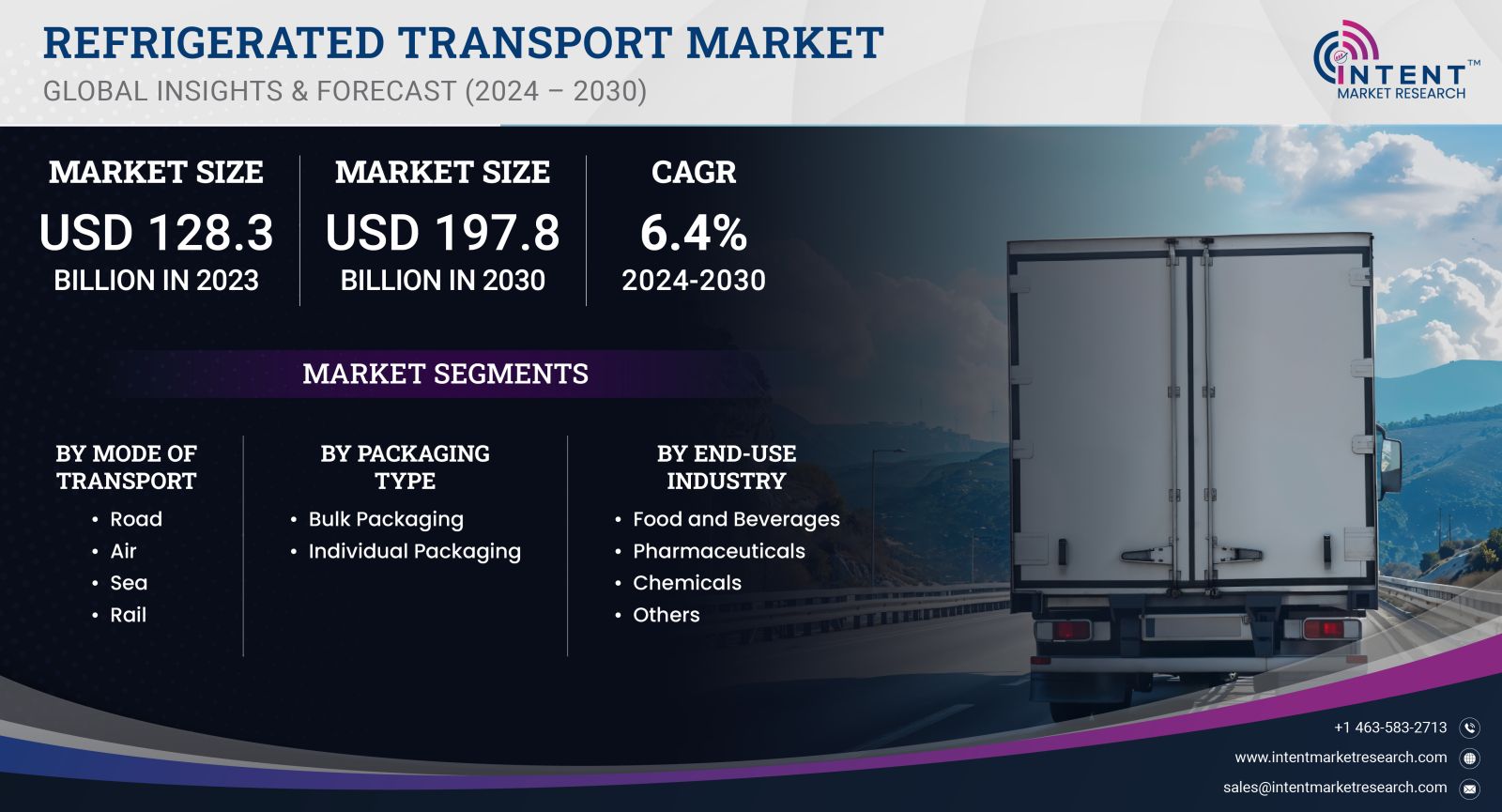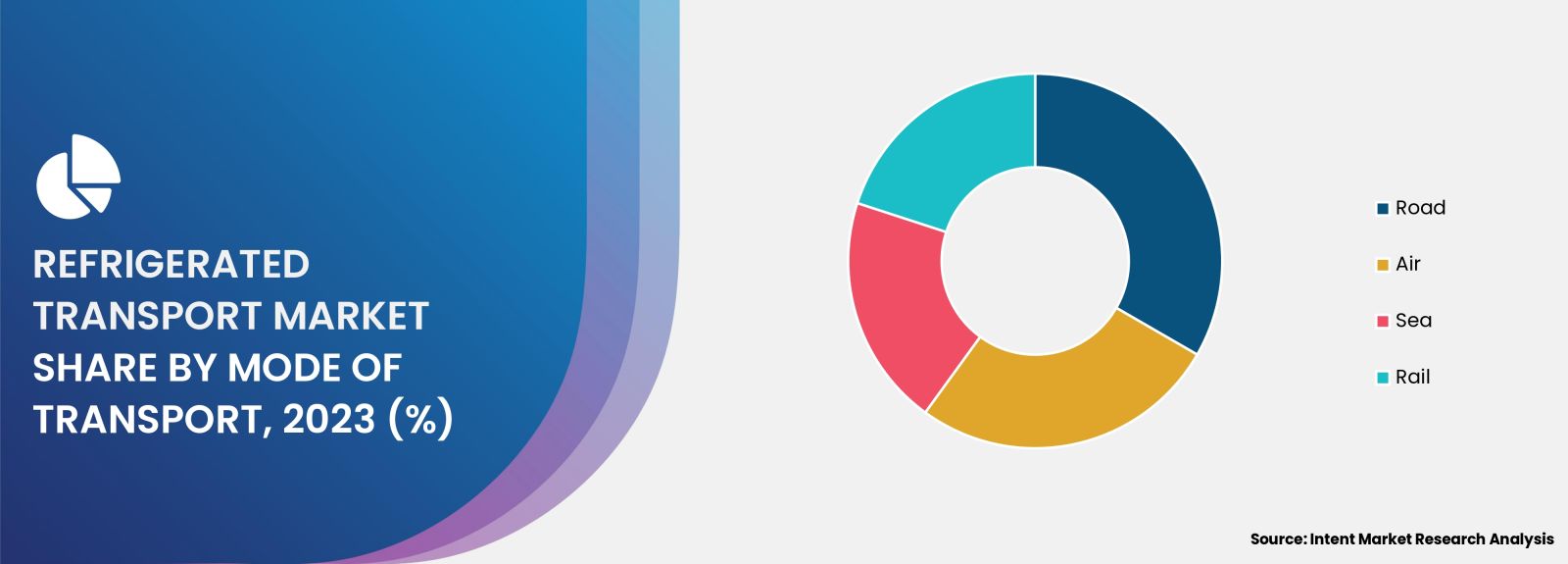 The Refrigerated Transport Market is an essential segment within the logistics and transportation industry, focusing on the transportation of perishable goods under controlled temperature conditions. With the increasing demand for fresh and frozen foods, pharmaceuticals, and other temperature-sensitive products, the market has witnessed substantial growth. As per Intent Market Research, the Refrigerated Transport Market was valued at USD 128.3 billion in 2023 and will surpass USD 197.8 billion by 2030; growing at a CAGR of 6.4% during 2024 - 2030.
The Refrigerated Transport Market is an essential segment within the logistics and transportation industry, focusing on the transportation of perishable goods under controlled temperature conditions. With the increasing demand for fresh and frozen foods, pharmaceuticals, and other temperature-sensitive products, the market has witnessed substantial growth. As per Intent Market Research, the Refrigerated Transport Market was valued at USD 128.3 billion in 2023 and will surpass USD 197.8 billion by 2030; growing at a CAGR of 6.4% during 2024 - 2030.

Vehicle Type Segment is Largest Owing to Expanding Heavy Commercial Vehicles Fleet
The vehicle type segment in the refrigerated transport market is categorized into Light Commercial Vehicles (LCVs), Medium Commercial Vehicles (MCVs), and Heavy Commercial Vehicles (HCVs). Among these, the Heavy Commercial Vehicles (HCVs) segment holds the largest market share. HCVs are predominantly used for long-distance transportation of perishable goods, making them essential for cross-border and interstate logistics.
As urbanization increases and global trade expands, the demand for efficient transportation of large volumes of perishable goods has become more prominent. The capacity of HCVs to transport larger shipments under controlled conditions has positioned them as a critical element in the cold chain logistics sector. Moreover, companies are investing in advanced refrigeration units and telematics solutions for these vehicles, enhancing their efficiency, safety, and compliance with regulatory standards, further boosting the growth of this subsegment.
Technology Segment is Fastest Growing Owing to Increased Adoption of Cryogenic Systems
The technology segment encompasses vapor compression systems, cryogenic systems, and eutectic devices. Among these, the cryogenic systems subsegment is expected to grow at the fastest rate during the forecast period. Cryogenic systems use liquid gases like nitrogen and carbon dioxide for refrigeration, providing an efficient and environmentally friendly alternative to traditional systems.
The rising focus on reducing carbon emissions and adhering to stringent environmental regulations has propelled the adoption of cryogenic systems. Their ability to maintain consistent temperatures for extended durations, even in challenging conditions, has made them the preferred choice for transporting high-value pharmaceuticals, frozen foods, and other temperature-sensitive products. Additionally, advancements in cryogenic technology, such as automated monitoring and real-time data tracking, have increased the operational efficiency of these systems, further fueling their growth.
Temperature Segment is Dominated by Chilled Transport Owing to Demand for Fresh Produce
Within the temperature segment, which includes chilled and frozen transport, the chilled transport subsegment holds the dominant market position. Chilled transport is critical for the delivery of fresh produce, dairy products, and other items that require temperatures above freezing but below ambient levels to maintain their freshness and quality.
The growing consumer demand for fresh, organic fruits and vegetables, as well as the expansion of grocery delivery services, has significantly increased the need for chilled transport. Retailers and logistics providers are investing in advanced cooling technologies and insulated containers to ensure that fresh produce reaches consumers without spoilage. This focus on freshness and quality, supported by government initiatives promoting the efficient distribution of agricultural products, has solidified the chilled transport subsegment’s leadership in the market.
Application Segment Shows Fastest Growth in Pharmaceuticals Owing to Stringent Regulations
The application segment is divided into food & beverages, pharmaceuticals, and chemicals. The pharmaceuticals subsegment is the fastest growing, driven by the rising need for temperature-controlled logistics to transport vaccines, biologics, and other medical products. The pharmaceutical industry relies heavily on precise temperature control to maintain product efficacy, especially for biologics and vaccines that are highly sensitive to temperature fluctuations.
Strict regulatory requirements from agencies such as the FDA and the European Medicines Agency (EMA) have pushed pharmaceutical companies to invest in state-of-the-art refrigerated transport solutions. Innovations like data loggers, GPS tracking, and real-time monitoring systems are becoming standard features, ensuring compliance and maintaining the integrity of pharmaceutical products throughout the transportation process. As the demand for personalized medicines and biologics rises, the pharmaceutical application segment is expected to witness sustained growth.
Mode of Transport Segment Led by Road Transport Owing to Flexibility and Cost-Effectiveness
In the mode of transport segment, which includes road, rail, air, and sea, the road transport subsegment is the largest. Road transport is widely used due to its flexibility, reach, and cost-effectiveness. It is particularly suitable for short to medium distances and allows for direct delivery, which is crucial for perishable goods that require timely transportation.
The expansion of road infrastructure, coupled with the development of advanced insulated and refrigerated truck solutions, has further boosted this segment. Companies are also integrating GPS and telematics to monitor vehicle routes and temperature conditions, ensuring high efficiency. This widespread adoption and the essential role road transport plays in connecting rural production areas with urban distribution centers have made it the largest subsegment within the mode of transport category.
Asia-Pacific Region is Fastest Growing Owing to Expanding Cold Chain Infrastructure
The Asia-Pacific region is projected to be the fastest-growing market for refrigerated transport from 2024 to 2030. Countries like China, India, and Japan are experiencing rapid growth in their food and pharmaceutical industries, creating a strong demand for efficient cold chain solutions. Additionally, investments in infrastructure development and the implementation of government policies to support cold storage and transport facilities have significantly contributed to the market's expansion in this region.
In China, for instance, initiatives aimed at enhancing food safety and reducing food wastage are boosting the demand for refrigerated transport services. Similarly, the Indian government’s emphasis on modernizing agriculture and increasing the availability of fresh produce in urban centers is driving the need for efficient cold chain logistics. The growing middle-class population in these countries, with an increasing preference for quality perishable goods, is expected to continue fueling growth in the region.
.jpg)
Competitive Landscape
The refrigerated transport market is highly competitive, with several key players focusing on expanding their technological capabilities and geographical reach. Leading companies such as Thermo King Corporation, Carrier Transicold, and Daikin Industries are investing in research and development to enhance their product offerings. They are introducing innovative refrigeration systems and telematics solutions to provide efficient, reliable, and environmentally friendly transport services.
Strategic partnerships, mergers, and acquisitions are also prominent as companies seek to strengthen their market position and expand their service networks. Additionally, the focus on meeting regulatory requirements and improving sustainability practices is pushing companies to develop advanced solutions that cater to the evolving needs of the market. As competition intensifies, maintaining a strong balance between cost efficiency, service quality, and technological advancement will be critical for companies to sustain their growth.
Report Scope:
|
Report Features |
Description |
|
Market Size (2023) |
USD 128.3 billion |
|
Forecasted Value (2030) |
USD 197.8 billion |
|
CAGR (2024 – 2030) |
6.4% |
|
Base Year for Estimation |
2023 |
|
Historic Year |
2022 |
|
Forecast Period |
2024 – 2030 |
|
Report Coverage |
Market Forecast, Market Dynamics, Competitive Landscape, Recent Developments |
|
Segments Covered |
Refrigerated Transport Market By Mode of Transport (Road, Air, Sea, Rail), By Packaging Type (Bulk Packaging, Individual Packaging), and By End-Use Industry (Food and Beverages, Pharmaceuticals, Chemicals) |
|
Regional Analysis |
North America (US, Canada, Mexico), Europe (Germany, France, UK, Italy, Spain, and Rest of Europe), Asia-Pacific (China, Japan, South Korea, Australia, India, and Rest of Asia-Pacific), Latin America (Brazil, Argentina, and Rest of Latin America), Middle East & Africa (Saudi Arabia, UAE, Rest of Middle East & Africa) |
|
Customization Scope |
Customization for segments, region/country-level will be provided. Moreover, additional customization can be done based on the requirements |
|
1. Introduction |
|
1.1. Market Definition |
|
1.2. Scope of the Study |
|
1.3. Research Assumptions |
|
1.4. Study Limitations |
|
2. Research Methodology |
|
2.1. Research Approach |
|
2.1.1. Top-Down Method |
|
2.1.2. Bottom-Up Method |
|
2.1.3. Factor Impact Analysis |
|
2.2. Insights & Data Collection Process |
|
2.2.1. Secondary Research |
|
2.2.2. Primary Research |
|
2.3. Data Mining Process |
|
2.3.1. Data Analysis |
|
2.3.2. Data Validation and Revalidation |
|
2.3.3. Data Triangulation |
|
3. Executive Summary |
|
3.1. Major Markets & Segments |
|
3.2. Highest Growing Regions and Respective Countries |
|
3.3. Impact of Growth Drivers & Inhibitors |
|
3.4. Regulatory Overview by Country |
|
4. Refrigerated Transport Market, by Mode of Transport (Market Size & Forecast: USD Million, 2022 – 2030) |
|
4.1. Road |
|
4.2. Air |
|
4.3. Sea |
|
4.4. Rail |
|
5. Refrigerated Transport Market, by Packaging Type (Market Size & Forecast: USD Million, 2022 – 2030) |
|
5.1. Bulk Packaging |
|
5.2. Individual Packaging |
|
6. Refrigerated Transport Market, by End-Use Industry (Market Size & Forecast: USD Million, 2022 – 2030) |
|
6.1. Food and Beverages |
|
6.1.1. Dairy Products |
|
6.1.2. Meat and Seafood |
|
6.1.3. Fruits and Vegetables |
|
6.1.4. Beverages |
|
6.1.5. Others |
|
6.2. Pharmaceuticals |
|
6.3. Chemicals |
|
6.4. Others |
|
7. Regional Analysis (Market Size & Forecast: USD Million, 2022 – 2030) |
|
7.1. Regional Overview |
|
7.2. North America |
|
7.2.1. Regional Trends & Growth Drivers |
|
7.2.2. Barriers & Challenges |
|
7.2.3. Opportunities |
|
7.2.4. Factor Impact Analysis |
|
7.2.5. Technology Trends |
|
7.2.6. North America Refrigerated Transport Market, by Mode of Transport |
|
7.2.7. North America Refrigerated Transport Market, by Packaging Type |
|
7.2.8. North America Refrigerated Transport Market, by End-Use Industry |
|
7.2.9. By Country |
|
7.2.9.1. US |
|
7.2.9.1.1. US Refrigerated Transport Market, by Mode of Transport |
|
7.2.9.1.2. US Refrigerated Transport Market, by Packaging Type |
|
7.2.9.1.3. US Refrigerated Transport Market, by End-Use Industry |
|
7.2.9.2. Canada |
|
7.2.9.3. Mexico |
|
*Similar segmentation will be provided for each region and country |
|
7.3. Europe |
|
7.4. Asia-Pacific |
|
7.5. Latin America |
|
7.6. Middle East & Africa |
|
8. Competitive Landscape |
|
8.1. Overview of the Key Players |
|
8.2. Competitive Ecosystem |
|
8.2.1. Level of Fragmentation |
|
8.2.2. Market Consolidation |
|
8.2.3. Product Innovation |
|
8.3. Company Share Analysis |
|
8.4. Company Benchmarking Matrix |
|
8.4.1. Strategic Overview |
|
8.4.2. Product Innovations |
|
8.5. Start-up Ecosystem |
|
8.6. Strategic Competitive Insights/ Customer Imperatives |
|
8.7. ESG Matrix/ Sustainability Matrix |
|
8.8. Manufacturing Network |
|
8.8.1. Locations |
|
8.8.2. Supply Chain and Logistics |
|
8.8.3. Product Flexibility/Customization |
|
8.8.4. Digital Transformation and Connectivity |
|
8.8.5. Environmental and Regulatory Compliance |
|
8.9. Technology Readiness Level Matrix |
|
8.10. Technology Maturity Curve |
|
8.11. Buying Criteria |
|
9. Company Profiles |
|
9.1. Carrier Global |
|
9.1.1. Company Overview |
|
9.1.2. Company Financials |
|
9.1.3. Product/Service Portfolio |
|
9.1.4. Recent Developments |
|
9.1.5. IMR Analysis |
|
*Similar information will be provided for other companies |
|
9.2. Daimler AG |
|
9.3. Dometic Group |
|
9.4. Great Dane |
|
9.5. Klinge Corporation |
|
9.6. Mitsubishi |
|
9.7. Schmitz Cargobull AG |
|
9.8. Trane Technologies |
|
9.9. Utility Trailer Manufacturing Company |
|
9.10. Volvo Group |
|
10. Appendix |
A comprehensive market research approach was employed to gather and analyze data on the Refrigerated Transport Market. In the process, the analysis was also done to analyze the parent market and relevant adjacencies to measure the impact of them on the Refrigerated Transport Market. The research methodology encompassed both secondary and primary research techniques, ensuring the accuracy and credibility of the findings.
.jpg)
Secondary Research
Secondary research involved a thorough review of pertinent industry reports, journals, articles, and publications. Additionally, annual reports, press releases, and investor presentations of industry players were scrutinized to gain insights into their market positioning and strategies.
Primary Research
Primary research involved conducting in-depth interviews with industry experts, stakeholders, and market participants across the Refrigerated Transport ecosystem. The primary research objectives included:
- Validating findings and assumptions derived from secondary research
- Gathering qualitative and quantitative data on market trends, drivers, and challenges
- Understanding the demand-side dynamics, encompassing end-users, component manufacturers, facility providers, and service providers
- Assessing the supply-side landscape, including technological advancements and recent developments
Market Size Assessment
A combination of top-down and bottom-up approaches was utilized to analyze the overall size of the Refrigerated Transport Market. These methods were also employed to assess the size of various subsegments within the market. The market size assessment methodology encompassed the following steps:
- Identification of key industry players and relevant revenues through extensive secondary research
- Determination of the industry's supply chain and market size, in terms of value, through primary and secondary research processes
- Calculation of percentage shares, splits, and breakdowns using secondary sources and verification through primary sources
.jpg)
Data Triangulation
To ensure the accuracy and reliability of the market size, data triangulation was implemented. This involved cross-referencing data from various sources, including demand and supply side factors, market trends, and expert opinions. Additionally, top-down and bottom-up approaches were employed to validate the market size assessment.
NA
